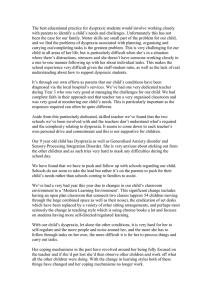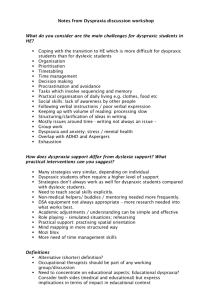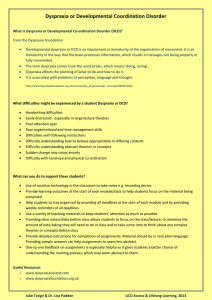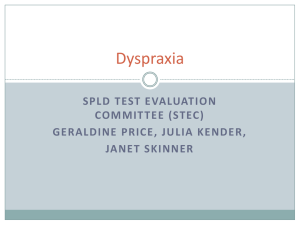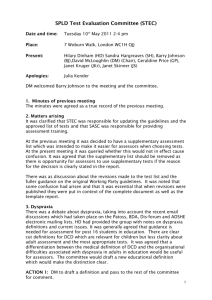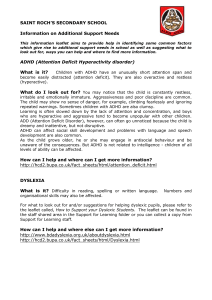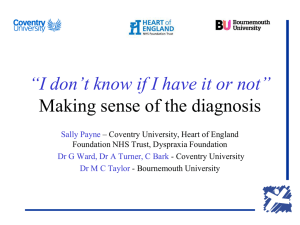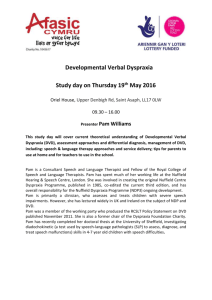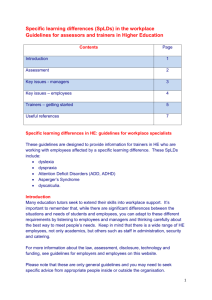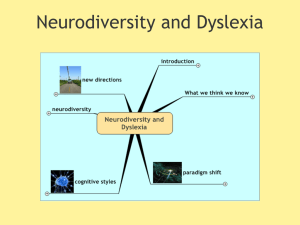Information for staff on dyspraxia
advertisement
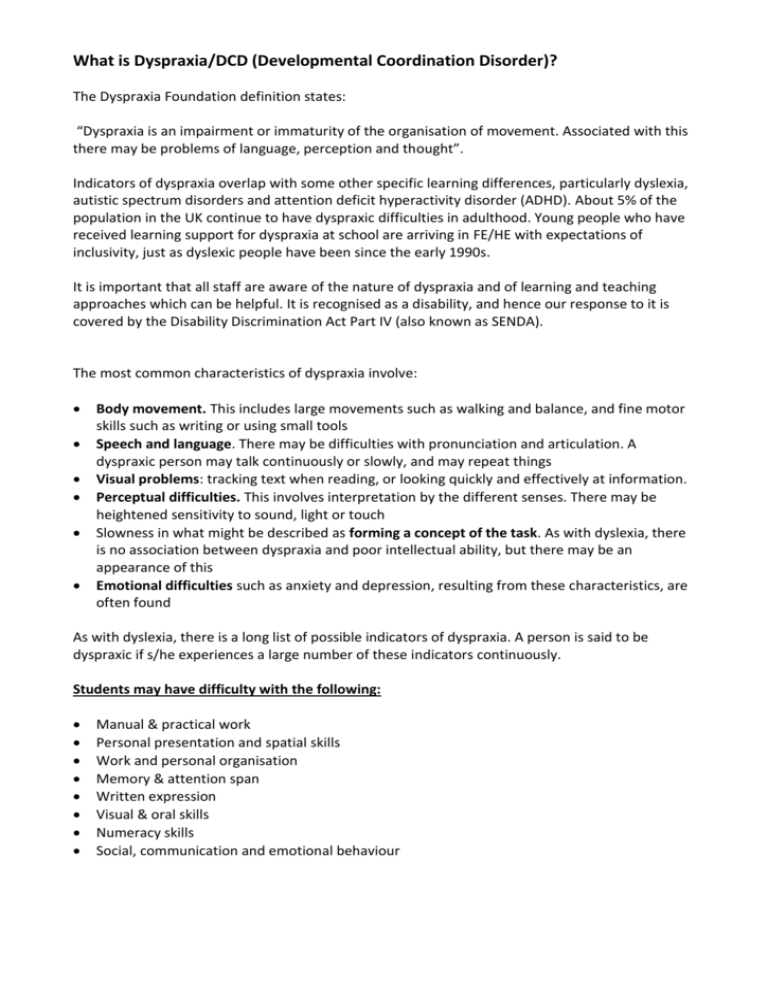
What is Dyspraxia/DCD (Developmental Coordination Disorder)? The Dyspraxia Foundation definition states: “Dyspraxia is an impairment or immaturity of the organisation of movement. Associated with this there may be problems of language, perception and thought”. Indicators of dyspraxia overlap with some other specific learning differences, particularly dyslexia, autistic spectrum disorders and attention deficit hyperactivity disorder (ADHD). About 5% of the population in the UK continue to have dyspraxic difficulties in adulthood. Young people who have received learning support for dyspraxia at school are arriving in FE/HE with expectations of inclusivity, just as dyslexic people have been since the early 1990s. It is important that all staff are aware of the nature of dyspraxia and of learning and teaching approaches which can be helpful. It is recognised as a disability, and hence our response to it is covered by the Disability Discrimination Act Part IV (also known as SENDA). The most common characteristics of dyspraxia involve: Body movement. This includes large movements such as walking and balance, and fine motor skills such as writing or using small tools Speech and language. There may be difficulties with pronunciation and articulation. A dyspraxic person may talk continuously or slowly, and may repeat things Visual problems: tracking text when reading, or looking quickly and effectively at information. Perceptual difficulties. This involves interpretation by the different senses. There may be heightened sensitivity to sound, light or touch Slowness in what might be described as forming a concept of the task. As with dyslexia, there is no association between dyspraxia and poor intellectual ability, but there may be an appearance of this Emotional difficulties such as anxiety and depression, resulting from these characteristics, are often found As with dyslexia, there is a long list of possible indicators of dyspraxia. A person is said to be dyspraxic if s/he experiences a large number of these indicators continuously. Students may have difficulty with the following: Manual & practical work Personal presentation and spatial skills Work and personal organisation Memory & attention span Written expression Visual & oral skills Numeracy skills Social, communication and emotional behaviour The following approaches can usefully be adopted by academic and support staff: In Lectures Give clear handouts Write new terms on board Accept use of Dictaphones Repeat & summarise the main points of the lecture Understand that students are easily distracted Videoing lectures can be very helpful Multi-sensory materials are also important Break things down into segments In Seminars & Tutorials Give students more time in general to frame and answer questions, and to work out how to perform a task Help students to prioritise books on the reading list Give extra time for course work Be aware that students are easily distracted by noise and movement Allow students to take regular breaks Show examples of essays and reports to help students know what is expected of them Give clear instructions and repeat them; supply written notes if possible Demonstrate procedures several times Leave nothing to the imagination Encourage them as much as possible, emphasising strengths Facilitate use of their best sensory modality, such as colour coding, auditory memory or opportunity to move about and shift position Let other students help them In terms of academic assessment, allow dyspraxic students to demonstrate their understanding by the means which best suits their learning difference. Examples: orally, voiced software, production of artefact, practical demonstration. Most dyspraxic students will have an Educational Psychologist’s report, and this should make recommendations about assessment. Strategies for the student include: When writing essays & reports One to one tuition at least once a week Help with planning & organisation e.g. concept maps Help with writing & paragraphing Help with proof-reading Help with time management & organisation Examinations (where appropriate and identification/recommendations from formal assessment have been made): Help with revision Extra time Use of a computer Scribe or reader when necessary Allowances for dyspraxia when marking Taking exams in a separate room to avoid distractions Technological Hardware Word processors with good spell- and grammar checks Lap tops Monitors - large monitors are easier to work with Computer mice - one that is easy to control e.g. Anir mouse Scanners Keyboards - large ergonomic ones Identification of Dyspraxia/DCD at Bath Spa University: Dyspraxia or DCD is diagnosed only by referral to a GP who will then refer the student on to an educational psychologist for full assessment. We do have a dyspraxia checklist (that can be found on the Bath Spa University website in Services under ‘Information for BSU Staff) Staff website in....... ) which can be a useful indicator of dyspraxic/DCD tendencies. It may be a useful tool if the student wishes to be referred on to their GP. If you have any questions or queries please contact: studentsupport@bathspa.ac.uk Other sources of information about dyspraxia: www.dyspraxiafoundation.org.uk www.danda.org.uk Adapted from: www.hcs.dmu.ac.uk
